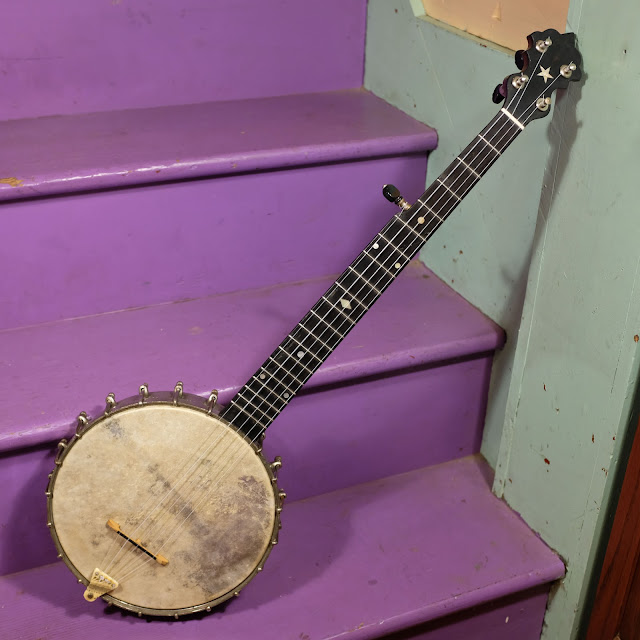1890 SS Stewart "Lady Stewart" 5-String Openback Banjo
A friend of mine brought this banjo in for his neighbor for resale. It's a small, adorable thing, and judging from the specs -- 22 1/2" scale and small, 9" pot -- it specs-out like a "Lady Stewart" from the time. This makes it a great banjo to tune up to A (which is what you're hearing in the video clip), but I'll bet it would sound even cooler in Bb or B. It has an excellent, nicely-loud, and surprisingly-full voice. The ears expect this to be a much larger instrument.
Its 5909 serial number places it right around 1890 and it definitely looks it. A good 3/4 of the hook/nuts were missing or damaged when this came in, the head was replaced with some weird, textured leather (not useful), and it only had a few of its original wood pegs. Miraculously, the original tailpiece is still extant, however.
Work included: a fret level/dress, replacement friction pegs (older Grover Champions at the headstock and an antique 5th peg), replacement hooks and nuts (all vintage and mismatched -- 1920s or earlier) for the rim, new bone nut, new plastic 5th pip/nut, replacement neck brace and shims, one replacement pearl inlay for the fretboard, some patching/cleaning to previous fills/non-repairs to hairline cracks in the board, a new thin skin head install, and of course the usual cleaning and setup. I used a parts-bin, lightweight bridge and have it strung with Aquila Nylgut strings. The neck is straight, the frets have good life left to them, and the action is spot-on for gut/nylon with 3/32" height at the 12th fret.
Its 5909 serial number places it right around 1890 and it definitely looks it. A good 3/4 of the hook/nuts were missing or damaged when this came in, the head was replaced with some weird, textured leather (not useful), and it only had a few of its original wood pegs. Miraculously, the original tailpiece is still extant, however.
Work included: a fret level/dress, replacement friction pegs (older Grover Champions at the headstock and an antique 5th peg), replacement hooks and nuts (all vintage and mismatched -- 1920s or earlier) for the rim, new bone nut, new plastic 5th pip/nut, replacement neck brace and shims, one replacement pearl inlay for the fretboard, some patching/cleaning to previous fills/non-repairs to hairline cracks in the board, a new thin skin head install, and of course the usual cleaning and setup. I used a parts-bin, lightweight bridge and have it strung with Aquila Nylgut strings. The neck is straight, the frets have good life left to them, and the action is spot-on for gut/nylon with 3/32" height at the 12th fret.
Scale length: 22 1/2"
Nut width: 1 1/8"
String spacing at nut: 7/8"
String spacing at saddle: 1 3/4"
Head diameter: 9"
Nut width: 1 1/8"
String spacing at nut: 7/8"
String spacing at saddle: 1 3/4"
Head diameter: 9"
Side depth: 2 1/8"
Head material: new thin goat skin
Rim wood: maple or cherry, stained
Rim wood: maple or cherry, stained
Tonering: spunover "hoop" on top edge -- so Little Wonder-style in vibe
Neck wood: cherry
Fretboard: ebony
Neck wood: cherry
Fretboard: ebony
Neck shape: flat board, medium soft-V frets 1-5, medium C frets 6+
Bridge: replacement ebony/maple
Serial number: 5909
Condition notes: replaced head, replaced tuners, replaced bridge, many replaced hook/nuts, one replaced pearl inlay, hailrine cracks/chip-out in fretboard that's been filled, average usewear throughout but not abused. The original tailpiece is nice to have. I had to shim the neck angle back a bunch, too, so there's a small air-gap at the side of the heel. The neck brace is antique but not original to the banjo and the wood shims for the brace are new.





















Comments